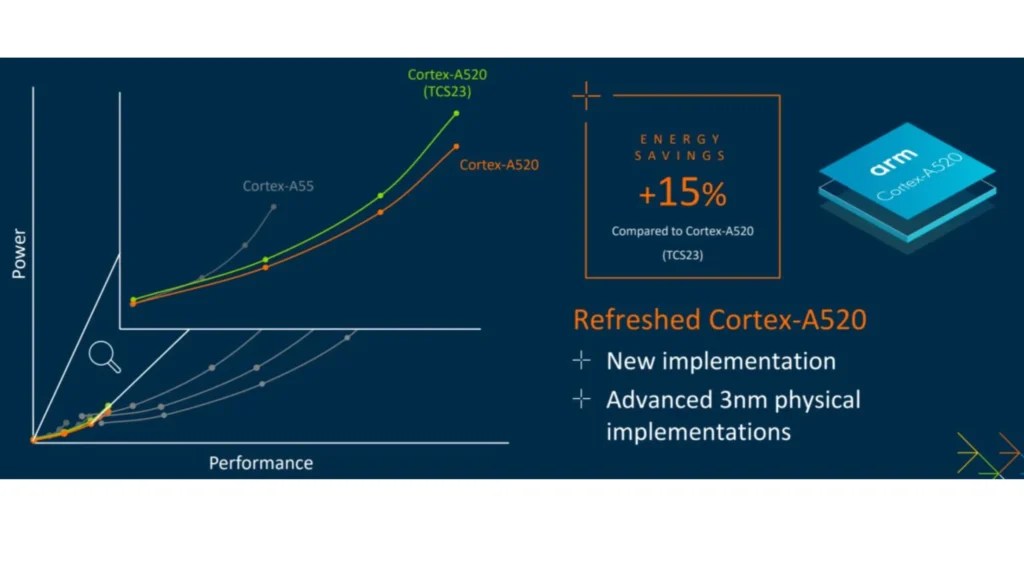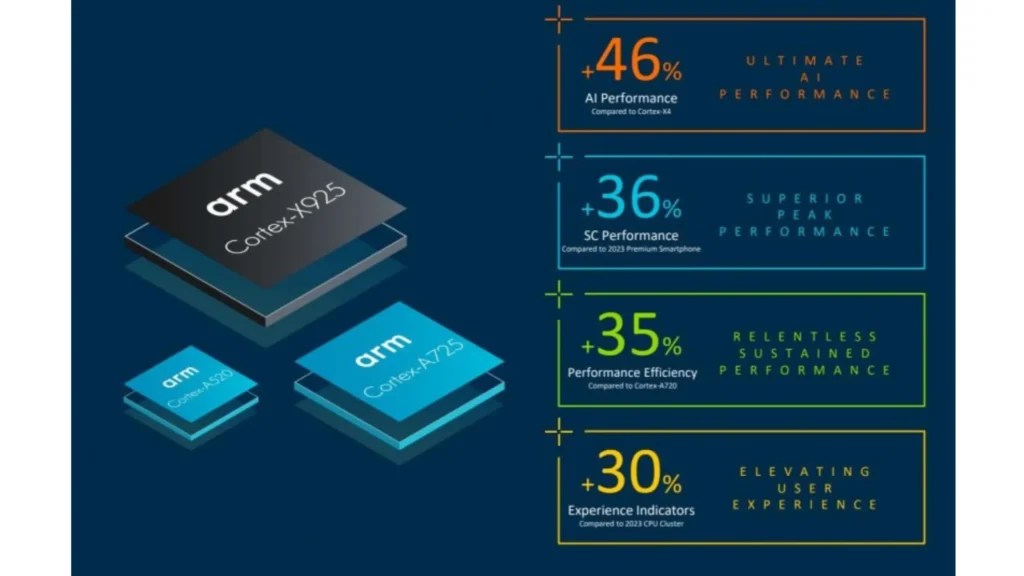New Armv9 CPUs: Performance, Efficiency, and Use Cases- Cortex-X925 vs Cortex-A725 vs Cortex-A520
ARM has unveiled its next-gen CPU cores, a refinement of the Armv9.2, with a focus on AI. The performance enhancements in the new cores are largely attributed to upgrades to the big and little cores, as well as optimizations made to the new 3nm architecture.
This architecture is compatible with both TSMC’s FinFET and Samsung’s GAA processes, demonstrating ARM’s commitment to versatility and innovation.

The Cortex-X925, successor to the Cortex-X4, offers 15% higher IPC performance, with a further 36% boost from the move to a 3nm process and a higher 3.6GHz clock. AI performance is 46% faster, which will be expected to see in 2025 flagship phones.
The Cortex-A720 is 25% more efficient than its predecessor, with a bigger L2 cache and a move to a 3nm process promising higher performance at lower power. The Cortex-A520, similar to the A510, also moves to the 3nm process for further power reduction. The Armv9.2 is expected to be used in 2025 flagship chipsets from Samsung, MediaTek, and Qualcomm.
Specifications and Features
Cortex-X925
- Performance: Highest performance uplift in Cortex-X history, 36% single-threaded performance improvement, 46% better AI performance.
- Microarchitecture: Optimized 3nm implementation, up to 3MB private L2 cache.
- Use Cases: Peak performance for applications like generative AI workloads, web browsing, camera post-processing, video recording, and AAA gaming.
- Efficiency: Enhanced power performance profile for better responsiveness and user experience.
- Integration: Part of Arm Compute Subsystems (CSS) for Client.
Cortex-A725
- Performance: 35% performance efficiency improvement, 25% power efficiency improvement over Cortex-A720.
- Microarchitecture: Optimized 3nm implementation, area optimized for mainstream consumer markets.
- Use Cases: Superior sustained performance for AI and gaming.
- Efficiency: Enhanced power and area efficiency for mainstream consumer devices.
- Integration: Co-designed physical implementation for better performance and efficiency.
Cortex-A520
- Performance: Refreshed for 15% efficiency improvements compared to previous generation (TCS23).
- Microarchitecture: Advanced 3nm physical implementation.
- Use Cases: Energy-efficient handling of low-intensity workloads like light media, idle, and background tasks.
- Efficiency: Best energy efficiency in the Cortex-A series.
- Integration: Enhanced as part of the CSS for Client.
Comparison: Cortex-X925 vs Cortex-A725 vs Cortex-A520


Performance
- Cortex-X925: Designed for ultimate peak performance, significantly enhancing single-threaded and AI performance. It is ideal for demanding applications and workloads.
- Cortex-A725: Balances performance and efficiency, providing superior sustained performance which is crucial for ongoing tasks and gaming.
- Cortex-A520: Focuses on energy efficiency, making it suitable for low-intensity tasks and ensuring background processes are handled with minimal power consumption.
Microarchitecture and Implementation
- Cortex-X925: Features a cutting-edge 3nm process and significant improvements in microarchitecture, including a large private L2 cache for enhanced configurability.
- Cortex-A725: Also leverages a 3nm process, with targeted improvements for mainstream markets and a balance between performance and efficiency.
- Cortex-A520: Benefits from advanced 3nm physical implementation aimed at energy efficiency, suitable for entry-level and background tasks.
Use Cases
- Cortex-X925: Suitable for high-intensity applications such as AI workloads, web browsing, and AAA gaming.
- Cortex-A725: Ideal for sustained performance needs, particularly in AI and gaming applications where continuous performance is key.
- Cortex-A520: Best for energy-efficient operations, making it perfect for lighter tasks and conserving battery life.
Integration in Arm Compute Subsystems (CSS)
- All three cores are integrated into the new Arm Compute Subsystems (CSS) for Client, contributing to the fastest compute platform for Android.
- Cortex-X925: Elevates peak performance for next-generation devices.
- Cortex-A725: Provides balanced performance and efficiency for a wide range of consumer devices.
- Cortex-A520: Ensures energy efficiency for lower-intensity and background tasks.
Final Thoughts
The Cortex-X925, Cortex-A725, and Cortex-A520 cores in the Armv9.2 CPU portfolio each bring unique strengths to the table. The Cortex-X925 offers the highest peak performance and significant AI improvements, making it suitable for the most demanding applications.
The Cortex-A725 provides a balance of sustained performance and efficiency, ideal for continuous workloads such as gaming and AI tasks. The Cortex-A520 focuses on energy efficiency, making it perfect for less intensive operations and ensuring better battery life. Together, these cores provide a versatile and powerful CPU cluster capable of enhancing the performance and efficiency of a wide range of consumer devices.
Source: via